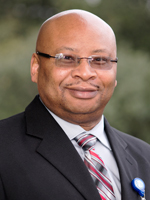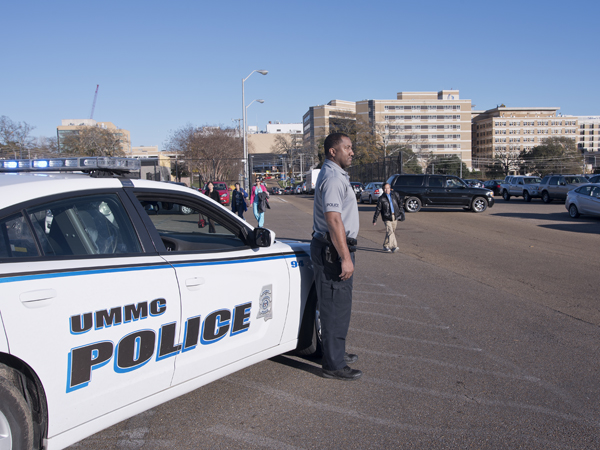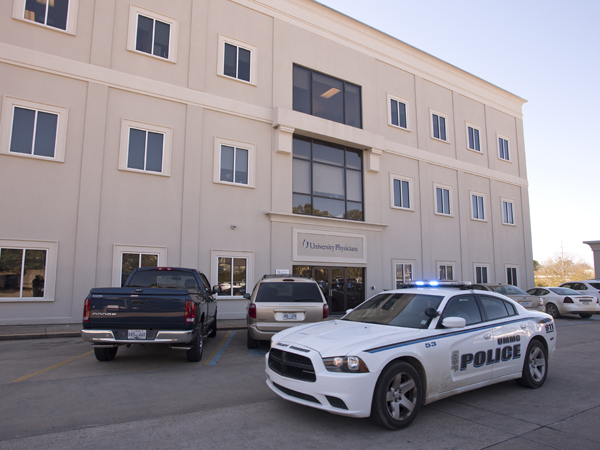Vigilance, awareness key to campus safety

If you come into a building on the University of Mississippi Medical Center campus, prepare to smile for the camera.
All points of entry are equipped with video cameras for real-time safety surveillance and to aid in forensic investigations. Internal cameras are posted in all common areas and at the entrance to each hospital unit. Also keeping out an eagle eye for the campus community's safety are the Medical Center's 67-member police force complemented by a 17-member team of security guards.
The Medical Center makes a huge investment in keeping employees, students and patients out of harm's way and making the largely urban campus crime-free. It's a serious undertaking for UMMC's 3.4 million gross square feet of buildings, with a total 4 million maintained, including parking garages. The campus has a 187-acre expanse and up to 25,000 people passing through on any given day.
“We want to be an inviting environment, but not a medical target,” said Jonathan Wilson, the Medical Center's chief administrative officer.

The recent carjacking, assault and shooting of a member of the UMMC community that began at the Fondren Hill apartments, just across the street from the Medical Center on Lakeland Drive, has heightened concerns and put a spotlight not just on crime, but UMMC's program of crime prevention and public safety.
“I think it's important for our patients, employees and students to know that our department takes 100 percent responsibility for everything that happens on campus,” said UMMC Police Chief Michael Stamps. “We are concerned about their safety, and we work hard to make our facility a crime-free place.”

“Enhanced patrols by both UMMC campus police and the Jackson Police Department in the surrounding community started immediately after the incident,” said a Friday memo to students and physician residents emailed by Associate Dean for Student Affairs Jerry Clark and Dr. Rick Barr, senior associate dean for graduate medical education and the Suzan B. Thames Professor and Chair of Pediatrics. Their memo encouraged them to report suspicious activity, work with their landlords to enhance security and report concerns to campus police and UMMC leadership.
“Recently, there's been a lot of concern about safety in Fondren Hill. Even though we can't patrol in the complex itself, we are increasing patrols in the area,” Stamps said. “JPD shares our concerns about keeping students, patients and employees safe.

“Chief Vance and I have an excellent working relationship, and he supports us 100 percent in our efforts. They've taken the initiative to do extra patrols on Lakeland Drive without us even asking, and crime has decreased in Precinct 3 (which encompasses the Medical Center) because of our joint effort.”
“The criminal element does not respect anyone's boundaries,” Vance said. “So, communication between law enforcement is crucial. We have former JPD officers who work at UMMC, and former UMMC officers who work at JPD. There are a lot of people who are familiar with each other, and working relationships that are established.”
Also critical, Vance said, is “the (investigative) information we can share. There is no place that you can go that is 100 percent crime free, but we're going to make every effort - JPD and UMMC - to get as close to that as we possibly can.”
Not to be downplayed is the role of the security guards, all UMMC employees. They're armed not with guns, but with radios to keep in communication with campus officers. “They are additional eyes and ears,” Wilson said. “If they see something suspicious or someone who needs help, they can alert campus police on their radios.”
Security guards' duties were expanded recently to address one of the top safety concerns of employees and students: traffic at the crosswalk on State Street, where drivers have been known to run red lights and travel at high speeds.

Other safety measures instituted by UMMC include new LED lighting around campus and the stadium, increased patrols around not just the stadium, but Medical Towers and the overflow parking lot, and increased patrols of Lakeland Drive between the campus and buildings on the other side of the street, including those owned by UMMC used for clinic space. “Anywhere there are people, we are increasing our patrols,” Stamps said.
Many areas of the Medical Center require badge access, and there are multiple security cameras mounted on traffic light poles around campus, Stamps said, “If you don't have identification on campus, we may ask you to identify yourself. We will challenge you.”
A number of Medical Center students and employees say they believe campus police are working hard to keep them safe, but that the recent carjacking gives them concern.
“I do feel safe at school,” said Kinnara Vasamsetti, a first-year School of Dentistry student. “In the short time I've been here, there have been no incidents that have caused me to feel unsafe. I see police officers constantly patrolling the stadium lot and around campus. I often leave late at night from school, and it's good to know that they are out there and keeping us safe.”
She wishes UMMC could “have a more positive influence on the surrounding community,” Vasamsetti said. “My concern stems from more recent events that hit so close to home. A lot of my friends live close to here, and we also study around school.”

Emily Cole, associate director of student records and registrar, said she's always felt safe walking to and from the stadium from her office. “But, I also know I have to be cognizant of my surroundings,” she said.
“There is police presence at the stadium, but I view it as a partnership. I don't stay late and walk alone, and I always look to see what's going on around me as I'm approaching my car.”
Third-year medical student Taylor Parks said he appreciates the police presence on campus. “I feel like there's always a police car patrolling the stadium or a golf cart or bike patrolman riding around the main streets,” he said. “Inside the buildings, I've never felt unsafe. Other than a computer charger being taken in the library, I've never heard of any issues on campus proper.”
Vasamsetti does what a lot of people do to be on the safe side. “I always try to walk with a group of students when I leave campus, or if I'm staying later, I move my car closer to school when possible to be safe,” she said.
“I always take off my earbuds after dark or when crossing the street because there are some cars that run red lights, but that is really out of UMMC campus safety's control,” Parks said.

Stamps agrees that the UMMC family and patients need to heed safety tips for personal safety.
“No matter what your environment is, criminals take advantage of opportunities,” he said. “If you walk out of your office, make sure it's secure before you leave. Sometimes people are so busy that they leave purses or laptops unattended or their car unlocked. Even though we are busy, we must know that someone can take advantage of us.”
He strongly stresses that if anyone sees someone or something that appears suspicious, they should notify campus police. “It takes every one of us to keep our campus safe,” Stamps said. “It's safe because so many people are vigilant.
“No law enforcement can take full credit. It takes the community, and we are only as good as our community.”
How UMMC police, crime stats stack up
How does UMMC's safety and security stack up against comparable campuses, and its police force compare with those in surrounding suburban cities?
Federal Bureau of Investigation uniform crime statistics for the year 2014, the most recent available, show that UMMC recorded one violent crime, one aggravated assault, 148 property crimes, three burglaries and 145 larcenies or thefts. There were no vehicle thefts, rapes or armed robberies.
Across the nation, there are relatively few similar-sized academic medical centers composed of an academic medical center and just students attending schools of medicine, dentistry, nursing and other health-related professions. UMMC's campus crime statistics, however, are in the same ballpark as several in the Southeast.
The Medical University of South Carolina in Charleston in 2014 recorded two violent crimes, two aggravated assaults, 99 property crimes and 99 larcenies or thefts. The University of Arkansas for Medical Sciences in Little Rock recorded two violent crimes, two aggravated assaults, 125 property crimes, two burglaries and 123 larcenies or thefts.
UMMC's police force of 67 sworn officers, all certified and trained at the Mississippi Law Enforcement Officers Training Academy in Pearl, and 17 security guards, soon to grow to 28, is comparable to -- if not bigger than -- those of surrounding cities excluding Jackson.
The city of Clinton has 53 sworn officers and 18 civilian employees, city officials say. Madison has 82 sworn officers and 22 civilian employees, and Ridgeland employs 72 sworn officers and 20 civilians.
Pearl has about 45 sworn officers and 20 civilian employees, and Brandon has 46 sworn officers and 15 civilians.
All five cities have a population of 23,000-25,000, about the same as people traffic flowing daily through UMMC.


